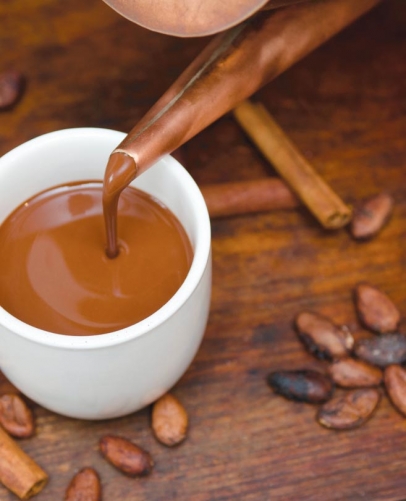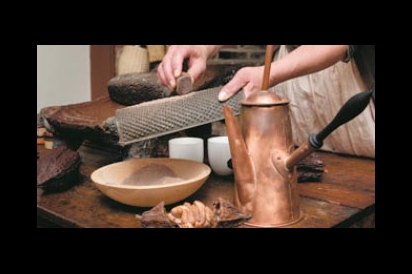The Taste of Chocolate in Colonial Newport
A Brief Local History of our Favorite Natural Mood Elevator
If you lived in Newport during the Colonial era, you would be familiar with many smells, both pleasant and unpleasant. And if lucky, you would be familiar with some of the best: those of roasting cocoa beans and hot drinking chocolate.
And you would have had one of Colonial America’s foremost businessmen, Aaron Lopez, to thank for your ready access to one of life’s most delicious pleasures. Lopez, who seemingly never missed a money-making opportunity, was involved in trading of many types. He traded women’s shoes, silk handkerchiefs, ships and barrels, building materials, furniture, spermaceti candles and, of course, chocolate.
He was also involved in the slave trade on and off. (Chocolate, as with sugar, was tied to slavery from the early days of its overseas trade.) Lopez came to Newport from Lisbon, Portugal, in 1750 at the age of 19, and by age 40 he was one of the wealthiest men in Newport, and an early supporter of Touro Synagogue.
Historically, chocolate was not the highly refined ambrosia we enjoy today. In their earliest uses by Central American people, as long ago as 1900 BC, cocoa beans were almost always made into a drink of some sort. The Mayans liked theirs warm—a “bitter, frothy” potion—while the Aztecs preferred a cold brew flavored with flower petals, chili pepper, allspice, vanilla or honey.
It was the Spanish who, after conquering Mexico in the 1520s, brought the cocoa bean back to Europe, where it was enjoyed as a drink, sweetened with cane sugar—another New World commodity—by those who could afford it.
Cocoa beans were imported into Boston as early as 1682. Chocolate making in North America during the 1700s was almost wholly concentrated in the northeast cities of Boston, New York, Philadelphia and Newport, with several individuals in each city working at the trade. Because of close trade ties with the West Indies, the market for the product in the colonies—especially New England—was wide open, allowing anyone of modest means to afford a stimulating morning cup of chocolate. It was even plentiful enough that chocolate was included in provisions given to the poor in almshouses.
Manufacturing raw chocolate is a fairly simple, albeit labor intensive, process. It starts with a cacao tree (ideally, many of them), on which grow football-shaped pods about six inches long. The pod is the fruit of the cacao tree. Once harvested, the beans are separated from the pods and left out to ferment for a few days. The beans are then dried for several more days in preparation for shipment. All of these steps must take place at or near the point of origin, within 20° latitude of the equator, where cacao trees grow best, to prevent spoilage in transit. In the 1700s, most of the labor would have been performed in or near Central America by African slaves.
The next steps were best performed in more temperate climes, which is one reason why Rhode Island and other northern colonies were the big producers of chocolate, despite the fact that southern colonies like Virginia were big consumers.
Similar to coffee beans, cocoa beans need to be roasted to attain a uniform color, bring out the chocolate flavor and loosen the hulls. Winnowing—repeatedly tossing the beans in a basket—separates the lighter hulls from the heavier meat of the bean—the cocoa “nibs”—which can then be ground into chocolate.
All these steps could be done at home, if you were so inclined. And this, in fact, is what Aaron Lopez undertook. Or rather, he employed people to do it for him, one of whom was recorded as a “negro” named Prince Updike, a master chocolate grinder. I say “employed” because Updike’s exact status at the time—enslaved or free—is not clear.
The Newport Historical Society has in its collections about 75 of Aaron Lopez’s account books, very detailed, spanning three decades of diverse business interests, of which chocolate was but one.
Lopez’s ledgers for the years 1766 to 1769 contain entries detailing Updike’s ground chocolate output, for which Lopez supplied the raw materials. In just one year, from 1766 to 1767, Updike produced 2,000 pounds of chocolate from 2,500 pounds of cocoa. He doubled the amount the following year to 4,000 pounds.
It’s not clear if Updike did only the grinding, or if he was also responsible for the roasting and hulling. Nor is it known if he enlisted members of his family or subcontracted in order to produce such quantities. For his efforts he received five shillings per pound of product.
It should be noted that these large quantities of chocolate produced by Updike coincided with the passing of the Revenue Act of 1767, which imposed a tax on, among other things, tea imported into the North American colonies. One result of this was that colonists switched to drinking chocolate or coffee as an alternative to tea. There’s an anecdote told of Martha Washington, that when imported tea was in disfavor because of the tax laws, she would instead enjoy a sort of chocolate tea, a brew made from cocoa hulls steeped in hot water.
Updike would have used a mano, an oblong stone, like a blocky rolling pin, on a metate, a concave, heated stone, to grind his chocolate. The grinding and the heat released the cocoa butter from the nibs, and the resulting paste had to be thoroughly worked to achieve the desired consistency. Modern small-batch scratch chocolate makers advise against using most home mixers and grinders available for coffee or food processing, as the engines quickly burn out. This should give an indication of how much elbow grease was required of Mr. Updike. An expert grinder could turn out about a pound of chocolate an hour.
Grinding also involved the mixing in of herbs and spices to refine the flavor of the chocolate. Updike may have used cinnamon, nutmeg, anise, dried orange rind, dried chili pepper, salt or vanilla and for some added color, annatto.
The resulting “chocolate liquor” was allowed to cool and harden into a big loaf, which was then cut into smaller bars known as “chocolate cake.” Unlike your favorite spongy chocolate layer cake, this type of cake was hard as a rock. Individually wrapped in paper, the cakes were distributed for sale to home cooks, coffee houses, military commissaries, etc. In use, chocolate was cut or shaved from the cakes as needed—to make a hot drink, or added to puddings or creams, or even ice cream. Any sweetening, in the form of crystallized cane sugar or honey, was added during preparation.
So did the drinking chocolate of the Colonial era taste like hot chocolate? Not so much. It tasted more like a melted bar of very dark bittersweet chocolate, thick, slightly grainy and very rich. The flavor is so concentrated that, like espresso, it was served in tiny demitasse cups. And of course the flavor profile would differ depending on the other ingredients that would be added.
The Revolution brought an end to Lopez’s Newport trade juggernaut. He was an ardent supporter of the cause of independence, despite the fact that the conflict severely curtailed his trading efforts and practically laid waste to the town of Newport. He fled to Portsmouth in 1776, then to Providence, and finally to Leicester, Massachusetts. When he drowned in a carriage accident in 1782, he was insolvent.
There is little physical evidence in Newport of the city’s chocolate manufacturing past. In years past Newport History Tours, a collaboration between the Newport Historical Society and the Newport Restoration Foundation, included a Working Waterfront tour that touched on the role of chocolate in Newport’s history. (The tour is expected to make a return in 2015.)
You can visit the graves of Prince Updike and Aaron Lopez. Updike, who died in 1781, is buried in the Common Burying Ground on Farewell Street. Lopez can be found in the Jewish Cemetery at the top of Touro Street.
For a Colonial chocolate experience you might want to travel to Boston, where Captain Jackson’s Historical Chocolate Shop opened in April 2013, part of the Old North Church Historic Site. There, costumed interpreters explain the chocolate manufacturing process, demonstrate grinding with mano and metate and give visitors a chance to try a sample of Colonial-era drinking chocolate. You can enjoy a similar experience at Colonial Williamsburg.
Newport History Tours
NewportHistoryTours.org • 401.841.8770
Captain Jackson’s Historical Chocolate Shop
OldNorth.com/CaptainJackson • 617.523.4848
Photos taken at Captain Jackson’s.






